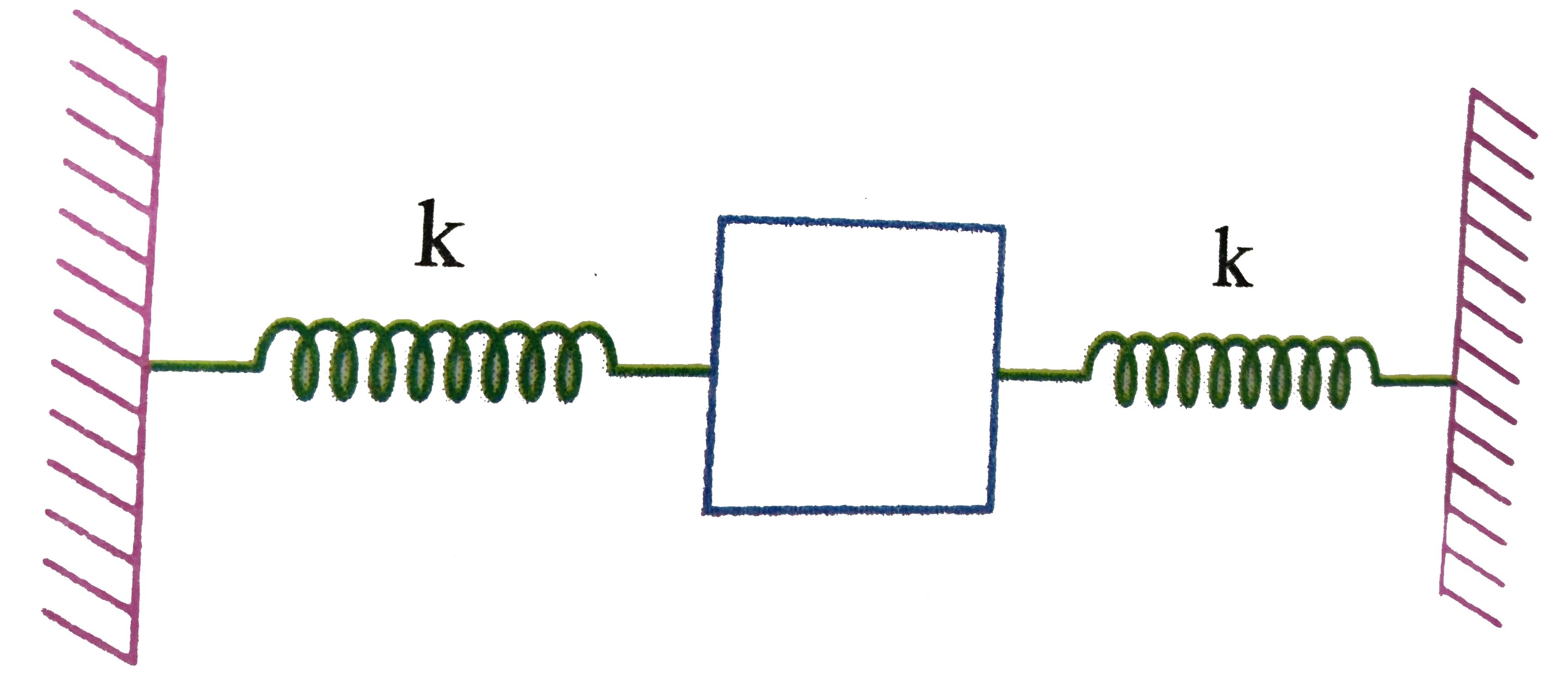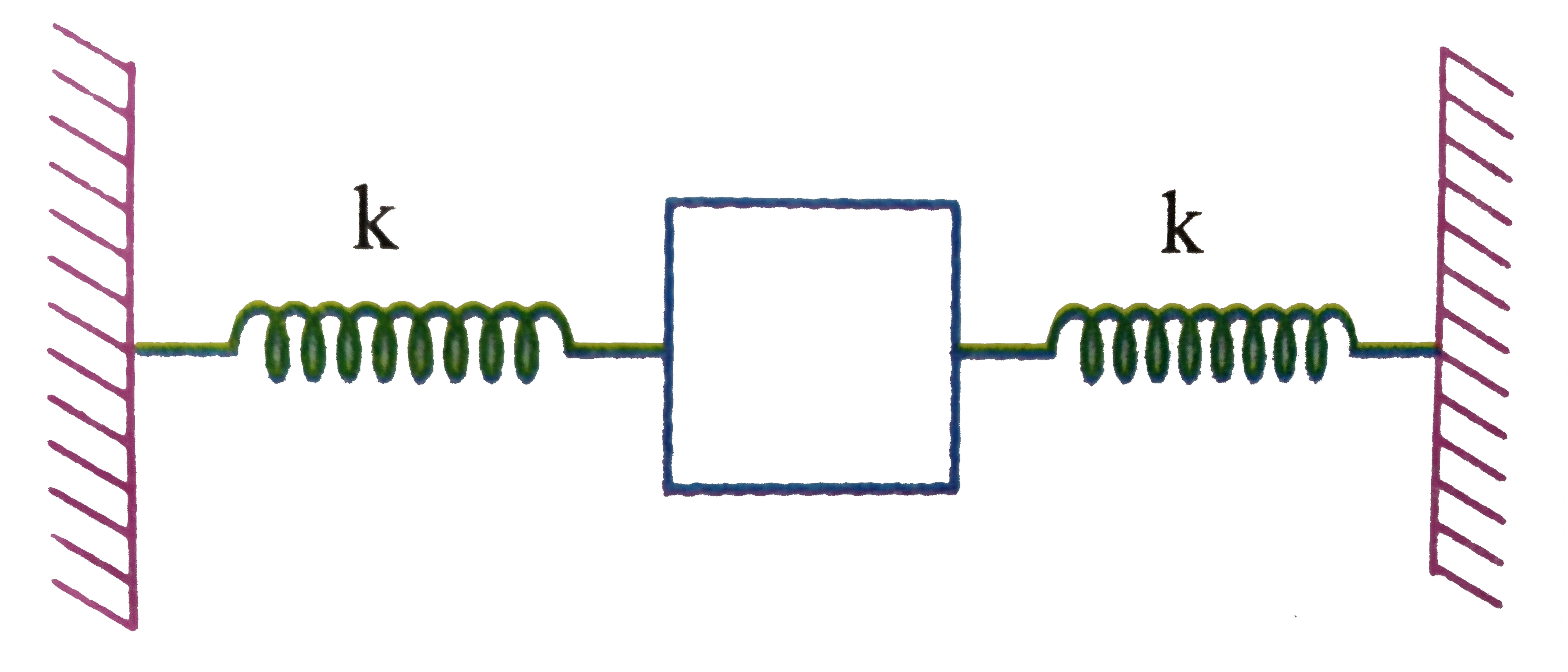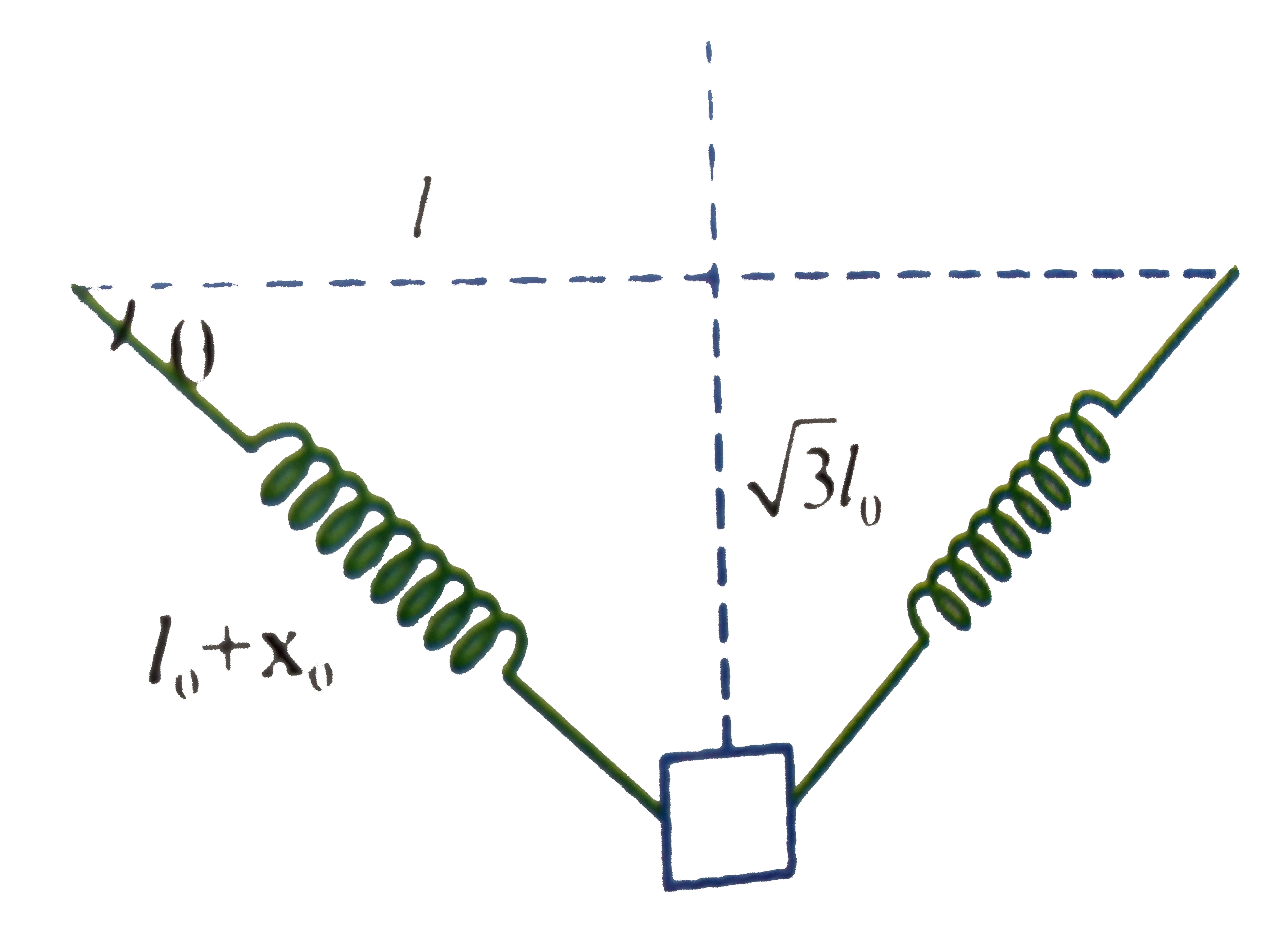A block is tied within two spring, each having spring constant equal to `k`. Initially the springs are in their natural length and horizontal as shown. The block is released from rest. The springs are ideal, acceleration due to gravity is `g` downwards. Air resistance is to be neglect. The natural length of spring is `l_(0)`.

If the decrease in height of the block till it reaches equilibrium is `sqrt(3l_(0))` then the mass of the block is:
A block is tied within two spring, each having spring constant equal to `k`. Initially the springs are in their natural length and horizontal as shown. The block is released from rest. The springs are ideal, acceleration due to gravity is `g` downwards. Air resistance is to be neglect. The natural length of spring is `l_(0)`.

If the decrease in height of the block till it reaches equilibrium is `sqrt(3l_(0))` then the mass of the block is:

If the decrease in height of the block till it reaches equilibrium is `sqrt(3l_(0))` then the mass of the block is:
A
`(2kl_(0))/(g)`
B
`(sqrt(2)kl_(0))/(g)`
C
`(sqrt(3)kl_(0))/(g)`
D
None of these
Text Solution
Verified by Experts
The correct Answer is:
C
A block is tied within two springs, each having spring constant equal to `k`. Initially the springs are in their natural length and horizontal as shown. The block is released from rest. The springs are ideal, acceleration due to gravity is `g` downwards. air resistance is to be neglect. The natural length of spring is `l_(0)`.

`l_(0) +x_(0) =sqrt(l_(0)^(2)+3l_(0)^(2)) = 2l_(0) rArr x_(0) = l_(0)`
`mg = [kx_(0) sin 60^(@)]2 = sqrt(3) kl_(0) rArr m = (sqrt(3)kl_(0))/(g)`
`tan theta = sqrt(3) rArr theta = 60^(@)`


`l_(0) +x_(0) =sqrt(l_(0)^(2)+3l_(0)^(2)) = 2l_(0) rArr x_(0) = l_(0)`
`mg = [kx_(0) sin 60^(@)]2 = sqrt(3) kl_(0) rArr m = (sqrt(3)kl_(0))/(g)`
`tan theta = sqrt(3) rArr theta = 60^(@)`

Topper's Solved these Questions
Similar Questions
Explore conceptually related problems
A block is tied within two spring, each having spring constant equal to k . Initially the springs are in their natural length and horizontal as shown. The block is released from rest. The springs are ideal, acceleration due to gravity is g downwards. Air resistance is to be neglect. The natural length of spring is l_(0) . If the decrease in height of the block till its speed becomes zero is sqrt(8l_(0)) then the mass of the block is:
A block is tied within two spring, each having spring constant equal to k . Initially the springs are in their natural length and horizontal as shown. The block is released from rest. The springs are ideal, acceleration due to gravity is g downwards. Air resistance is to be neglect. The natural length of spring is l_(0) . If the block is under equilibrium and the angle made by the spring with horizontal is 60^(@) then the mass of the block is:
Find the maximum tension in the spring if initially spring at its natural length when block is released from rest.
A block of mass m is attached to a spring of force constant k whose other end is fixed to a horizontal surface. Initially the spring is in its natural length and the block is released from rest. The average force acting on the surface by the spring till the instant when the block has zero acceleration for the first time is
Initially spring is in natural length and both blocks are in rest condition. Then deter mine maximum extension in spring . K = 20 N/M
A block is released from height h , find the maximum compression of spring of spring constant k .
The block of mass m is released when the spring was in its natrual length. Spring constant is k. Find the maximum elongation of the spring.
A block of mass m attached with a spring and held by a person such that the spring is in natural length l_(0) . Now the man releases the block, the ratio of maximum compression in the spring in the given situation , to that of the compression at equilibrium position.
The block shown in figure is released from rest and initially the spring is at its natural length. Write down the energy conservation equation. When the spring is compressed by l_(1) ?
Knowledge Check
A block is tied within two spring, each having spring constant equal to k . Initially the springs are in their natural length and horizontal as shown. The block is released from rest. The springs are ideal, acceleration due to gravity is g downwards. Air resistance is to be neglect. The natural length of spring is l_(0) . If the decrease in height of the block till its speed becomes zero is sqrt(8l_(0)) then the mass of the block is:
A block is tied within two spring, each having spring constant equal to k . Initially the springs are in their natural length and horizontal as shown. The block is released from rest. The springs are ideal, acceleration due to gravity is g downwards. Air resistance is to be neglect. The natural length of spring is l_(0) . If the decrease in height of the block till its speed becomes zero is sqrt(8l_(0)) then the mass of the block is:
A
`(2kl_(0))/(g)`
B
`(sqrt(2)kl_(0))/(g)`
C
`(sqrt(3)kl_(0))/(g)`
D
None of these
A block is tied within two spring, each having spring constant equal to k . Initially the springs are in their natural length and horizontal as shown. The block is released from rest. The springs are ideal, acceleration due to gravity is g downwards. Air resistance is to be neglect. The natural length of spring is l_(0) . If the block is under equilibrium and the angle made by the spring with horizontal is 60^(@) then the mass of the block is:
A block is tied within two spring, each having spring constant equal to k . Initially the springs are in their natural length and horizontal as shown. The block is released from rest. The springs are ideal, acceleration due to gravity is g downwards. Air resistance is to be neglect. The natural length of spring is l_(0) . If the block is under equilibrium and the angle made by the spring with horizontal is 60^(@) then the mass of the block is:
A
`(2gl_(0))/(sqrt(2))`
B
`(sqrt(2)gl_(0))/(sqrt(3))`
C
`(4gl_(0))/(sqrt(3))`
D
None of these
Find the maximum tension in the spring if initially spring at its natural length when block is released from rest.
Find the maximum tension in the spring if initially spring at its natural length when block is released from rest.
A
mg
B
mg/2
C
3mg/2
D
2 mg